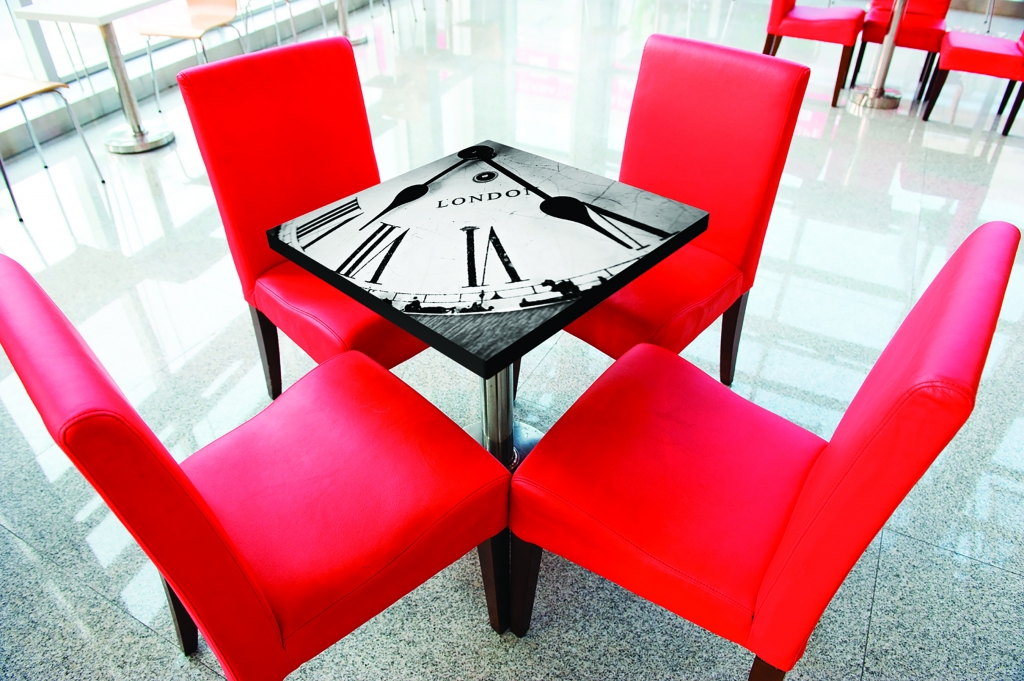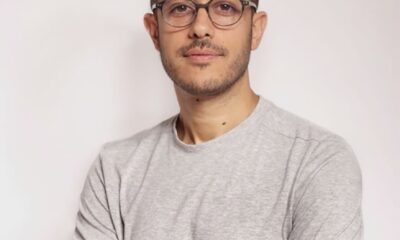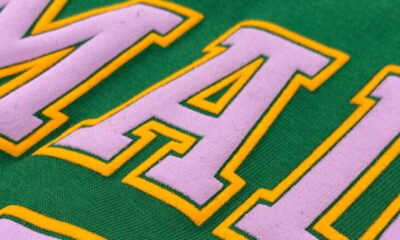Trends
Why Hard-Surface Dye Sublimation Is Heating Up
High-definition dye sublimation on rigid substrates offers fresh options for printing gifts, interior décor, and more.
Published
7 years agoon

BRILLIANT IMAGES printed via dye sublimation onto soft materials such as textiles, garments, and fabric banners are everywhere these days – at tradeshows, shopping malls, gyms, and sporting events. But we’re also starting to see more dye sublimated hard surfaces, including wall décor in art galleries, museums, photography studios, healthcare facilities, hotels, restaurants, offices, and homes.
 Photo courtesy of Roland.
Photo courtesy of Roland.
An advanced inkjet version of the sublimation processes screen printers first used decades ago to decorate polyurethane-coated coffee mugs is now being used for fine art reproduction, photo enlargements, and commercial interiors. It’s not an entirely new development, but as the technology continues to improve, it has gained significant momentum recently, especially in America. “Europe has been doing architectural sublimated graphics and sublimation onto rigid substrates for a while now, and the US is following suit,” says Lily Hunter, product manager of textiles and consumables for Roland DGA.
Just as with textile dye sublimation, the exquisite detail and brilliant color that can be achieved on rigid materials is creating demand with both print providers and consumers. High-definition photo panels are giving artists, photographers, and printmakers durable, easy-to-hang alternatives to prints on inkjet canvas or art papers – producing images of such quality that they look as if they are backlit. Manufacturers of laminates for architectural projects are promoting the beauty and durability of customized, dye sublimated surfaces for a growing range of materials and applications. The more that these products resonate with consumers, the faster manufacturers respond with new ideas that continue to take dye sublimation further from its roots in the gift and awards industry.
Photo courtesy of Blazing Editions.
Innovation + Marketing = Growth
Now that inkjet dye sublimation printers are fast, reliable, and capable of creating incredible image quality, the engines of innovation have shifted into high gear.
According to dye sublimation evangelist David Gross of Conde Systems, thousands of researchers are working on advanced inks, coatings, and sublimation-ready substrates to unleash the full potential of the technology. Just as Thomas Edison couldn’t imagine everything that’s now possible with lighting and electricity, we probably can’t yet envision all of the applications for dye sublimation, but the future looks tantalizing.
On Etsy, a search for dye sublimation brings up 84 pages of products, including monogrammed car mats, marble printed desk mats, motivational signs, drink coasters, metal cuff bracelets, personalized can openers, and metal save-the-date announcements.
For screen printers, who are already accustomed to working with an almost unlimited range of substrates, the ability to extend sublimation onto hard surfaces creates endless opportunities to develop and market their own innovative products. As Gross points out, you can create new forms of licensed products for current buyers of decorated apparel. Or, you could specialize in indoor signs or custom décor. Once you choose a substrate and innovate around it, you’ll find many different products you can create with sublimated pieces of metal or acrylic. Conde recently introduced ColorLyte acrylic blanks featuring a sublimation coating on the back designed to eliminate the need to print an image in reverse or a layer of white to make colors and image details pop.
According to Josh Hope, senior manager of industrial printing business development and marketing at Mimaki USA, screen printing companies have the extra advantage of being able to apply dye sublimation coatings to whatever rigid substrate they choose. For companies already equipped with large heat transfer presses, the ramp up to producing large-format inkjet dye sublimation on rigid substrates can be very short.
As with any new inkjet substrate, the ultimate value of each new opportunity for sublimation comes from two things: the beauty, originality, and appeal of the printed design; and the quality and effectiveness of the marketing. Products marketed as if they could be sold in Neiman Marcus command higher prices than those that look like they could be purchased at your local flea market.

Photo courtesty of DuraPlaq.
Screen printers who haven’t yet experimented with inkjet sublimation should get started, because the business is going to grow even larger with the advent of mass customization and on-demand manufacturing. “Compared to other decorating techniques, startup costs are among the lowest you’ll find, and return on investment is fast because sublimated products often command premium prices,” says Mike McEvoy, director of marketing communications for Sawgrass Systems. “People pay for quality, personalization, and beautiful imagery. Sublimation allows all kinds of businesses to deliver it all.”
For shops unfamiliar with transfer printing, color management can still be a challenge, because the process includes additional variables such as heat, pressure, and dwell time. “The key is process consistency,” says Hope. “Once you have the workflow down and have minimized any variables, then you can successfully control color.”
Hope advises smaller screen printing shops to investigate the range of products they want to produce to ensure their dye sublimation inks are compatible: “Testing is key and most manufacturers are willing to help in that process. Also be sure to look forward and think about the maximum size of products you will be working with so your heat press can accommodate them.” If you anticipate doing only a small number of large pieces, you can outsource those and focus on your core products.
Custom Décor on Demand
Gross says that the era of digital decoration is fully upon us, pointing out that sublimation’s growth is being fueled by a new generation of consumers who have come to expect its unique combination of features. New home buyers who grew up with digital photography know that images can be printed on almost any surface they choose. Instead of buying mass-produced furniture, they may prefer items that reflect their interests, experiences, or personalities. In the coming era of mass customization, many products might not be manufactured until after an order has been received.
For example, a new venture called Cloth & Company has partnered with Skyline Furniture in Chicago to bring the “fast fashion” concept to upholstered furniture. They are working with retail partners such as One Kings Lane, Overstock.com, and Wayfair to offer custom decorated upholstered beds, settees, chairs, benches, window treatments, and decorative pillows. Each item will be manufactured and shipped within six days of receiving the order.
If furniture and fashion can be custom manufactured on demand, so can many other home décor products. It presents a whole new era for dye sublimation in the manufacturing of consumer goods. Years ago, some of the first “industrial” products to be customized with inkjet dye sublimation included snowboards, skateboards, and skis. Now, different types of dye sublimation processes can be used by manufacturers of floors mats, laminated surfaces, building materials, and dinnerware, and examples are beginning to abound.
Photo courtesy of Avianix.
In conjunction with its partner United States Dinnerware (manufacturers of products sold under the Prolon brand name), Avianix recently introduced FDA-approved food service products that can be decorated with AvianiTrans 3D dye sublimation vacuum films, 3D vacuum heat presses, and hydro/aqua dye sublimation technologies. The dinnerware is dishwasher- and microwave-safe up to 350 degrees F. The company’s blanks include coasters, plates of various sizes and designs, platters, and bowls, which are ready for sublimation decorating without the need for a print-receptive polyester coating, according to United States Dinnerware President Steve Gluck. Avianix is working with additional molding companies globally to produce goods that can be digitally decorated.
ATI Decorative Laminates is promoting its Fusion dye sublimation process for personalizing brand environments and homes. In addition to wall art, ATI is using dye sublimation printing to custom decorate divider panels, displays, and large, multipanel murals. While ATI can also produce many of these items with direct digital flatbed printers, ATI says dye sublimation allows the properties of the underlying metal or wood to enhance the overall look of the image. The sublimated images are incredibly smooth and durable, and won’t scratch or peel.
Archi-Texture Finishing (A-Tex) is a licensee of Decoral System, which developed an industrial dye sublimation process that applies wood, marble, and similar designs to metals and other materials that will be powder-coated for outdoor durability. Decoral’s process allows high-resolution images printed on plastic film with UV-stable inks to be transferred into durable, weather-resistant powder coatings. Decoral finishes have been used on doors, windows, ceilings, wall panels, and flooring materials. The finishes resist chipping and peeling, withstand corrosion, and endure exposure to sun, heat, and rain.
Bison Coating & Supply produces sublimatable glass, steel, porcelain, and tumbled-stone tiles for decorative accents and murals in commercial and residential décor. Their textured wall tiles can be used in showers and as backsplashes.
And in the large-format printing world, ChromaLuxe metal and wood photo panels have captured the imagination of photographers, artists, and designers in more than 65 countries. Manufactured by Universal Woods, also known for the Unisub line of sublimatable products for gifts and awards, Chroma-Luxe panels allow for high quality image reproduction and are highly resistant to surface abrasion, humidity, atmospheric ozone, and contact with water. Metal prints can be safely displayed in public spaces without the need for framing under glass or acrylic, face mounting, or surface laminating.

Photo courtesy of Charleston Gallery on King Street.
At the 2017 Wedding and Portrait Photographers Expo in February, Universal Woods showed works by leading fine art, commercial, portrait, and wedding photographers in four separate galleries. The prints were produced on ChromaLuxe panels by each photographer’s preferred print provider. The company displayed a wider variety of its hard surfaces for dye sublimation at the BDwest hospitality design show in April. “We lead with our wall décor products, which consist of the wood and metal prints,” says Ryan Holtzman, ChromaLuxe brand manager, commercial channel. “We also show our tabletops and flooring products. But we make sure to show our line of other products such as phenolic, fiber-reinforced plastics, and steel [panels] with dry erase.”
More Innovations in the Works
Beyond the increasing demand for customized goods and the rapidly expanding availability of blank goods that are compatible with dye sublimation, there is no question that improvements to the technology have contributed to its growth in rigid substrate applications. Inkjet technology itself has progressed, and as demand for high quality imaging on rigid substrates has increased, many print service providers have added newer six- and eight-color dye sublimation printers from manufacturers such as Mimaki, Roland, Mutoh, Ricoh, and Sawgrass. Many have also added bigger heat presses from companies such as George Knight, ATI, and Monti Antonio, enabling them to tackle ideas that can’t be executed with older models. Hunter points out that newer specialized heat presses such as 3D vacuum models are driving further innovation by print providers.

Photo courtesy of Mimaki.
Rising interest in rigid substrates for dye sublimation can also be attributed to advancements in transfer (“ink release”) papers. In the early days of dye sublimation, separate papers were required for textiles and rigid substrates. Manufacturers of papers designed for textile sublimation were more concerned about releasing ink deep into the fabric than with high quality photo reproduction.
New hybrid dye sublimation transfer papers can transfer designs onto either textiles or rigid substrates. Hybrid papers make sense for sporting-goods businesses that use a single dye sublimation printer to decorate a mix of sportswear and equipment.
But for higher-volume, color-critical printing of soft signage and metal prints, you might want to load one wide-format printer with transfer papers optimized for textiles and another with papers for high quality imaging on rigid substrates. At Photokina 2016, Sihl introduced one such product, SubliColor Impact Paper 110 Matte, specifically for dye sublimation of high-resolution photos, images, and graphics on coated metal, wood, or ceramic items.

Photo courtesy of Sawgrass.
Image permanence has been another focus of intense research. ChromaLuxe, for example, has been working with ink developers at Sawgrass to reduce the effects of UV light on the colorfastness of dye sublimated photo prints. The eight-cartridge set of Sawgrass SubliJet IQ Pro Photo XF inks features three shades of black inks that not only promote longevity, but also enhance skin tones and the neutral blacks and detail that fine art and photographic prints demand. The inks are used in the Sawgrass 25-inch Virtuoso HD Product Decorating System.
Image permanence tests by Wilhelm Imaging Research have given dye sublimation photo prints on ChromaLuxe panels an image permanence rating of 64 years with Sawgrass SubliJet IQ Pro Photo XF inks and 65 years with Epson UltraChrome DS inks. This means the unframed metal panels are more stable and longer-lasting than prints on photo papers used in traditional silver-halide photo processing.
Extending the outdoor life of dye sublimation prints on rigid panels is another avenue of research. Currently, some dye sub prints can last 12 or 18 months outdoors without fading. Advances in inks, coatings, and substrates might make it possible to create signs that could last three to five years outdoors.
“Our current products are perfect for indoor use, but are not rated to outdoor use,” says Holtzman. “People do use them outdoors, though, and have varying levels of success based on placement. We will have a product coming out soon that will be intended for outdoor use.”
Wilhelm notes that not all materials for making metal prints have the same properties: “Very complex interactions take place between sublimation inks and the ink-receptive polymer coatings of dye sublimation prints, both during the short, high-heat image transfer step involved as well as very gradually over time, during the long-term display and storage of the prints. What a print looks like when it emerges from the heat press tells you nothing about how long it will last.” Such advancements will further refine a technology that has proven itself in the market. “Dye sublimation technology can be considered mature in that it is stable and repeatable,” says Hope. He believes continuing innovation in dye sublimation will reduce production times, bring costs down, and increase the number of substrates for dye sublimation.
Barry Brown of Visigraph believes dye sublimation printing will continue to emerge as one of the favorite forms of printing products, both rigid and fabric: “New breakthroughs are pointing to the potential for dye sublimation to be used on printed signs and displays where long-term usage is required,” he writes in a recent blog. “Literally the sky is the limit with dye sublimation printing on rigid substrates.”
Eileen Fritsch is a Cincinnati-area-based freelance writer who served as assistant editor of Screen Printing magazine in 1994 before being named a founding editor of Big Picture magazine.

SPONSORED VIDEO
Let’s Talk About It
Creating a More Diverse and Inclusive Screen Printing Industry
LET’S TALK About It: Part 3 discusses how four screen printers have employed people with disabilities, why you should consider doing the same, the resources that are available, and more. Watch the live webinar, held August 16, moderated by Adrienne Palmer, editor-in-chief, Screen Printing magazine, with panelists Ali Banholzer, Amber Massey, Ryan Moor, and Jed Seifert. The multi-part series is hosted exclusively by ROQ.US and U.N.I.T.E Together. Let’s Talk About It: Part 1 focused on Black, female screen printers and can be watched here; Part 2 focused on the LGBTQ+ community and can be watched here.
You may like
Advertisement

The Profit Impact of a Market Dominating Position

Inkcups Announces New CEO and Leadership Restructure

Hope Harbor to Receive Donation from BlueCotton’s 2024 Mary Ruth King Award Recipient
SUBSCRIBE

Bulletins
Get the most important news and business ideas from Screen Printing magazine's news bulletin.
Advertisement
Latest Feeds
Advertisement
Most Popular
-

 Case Studies2 months ago
Case Studies2 months agoHigh-Density Inks Help Specialty Printing Take Center Stage
-

 Art, Ad, or Alchemy2 months ago
Art, Ad, or Alchemy2 months agoF&I Printing Is Everywhere!
-

 Andy MacDougall2 months ago
Andy MacDougall2 months agoFunctional and Industrial Printing is EVERYWHERE!
-

 Columns3 weeks ago
Columns3 weeks ago8 Marketing Mistakes Not to Make When Promoting Your Screen Printing Services Online
-

 Editor's Note2 weeks ago
Editor's Note2 weeks agoLivin’ the High Life
-

 Marshall Atkinson2 weeks ago
Marshall Atkinson2 weeks agoHow to Create a Winning Culture in Your Screen-Printing Business
-

 Thomas Trimingham2 months ago
Thomas Trimingham2 months ago“Magic” Marketing for Screen Printing Shops
-

 News & Trends2 months ago
News & Trends2 months agoWhat Are ZALPHAS and How Can You Serve Them in Your Print Business?













